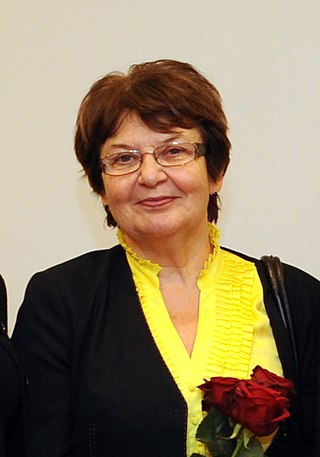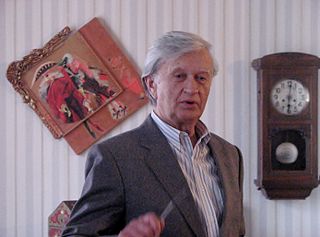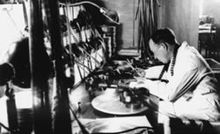
The culture of Estonia combines an indigenous heritage, represented by the country's Finnic national language Estonian, with Nordic and German cultural aspects. The culture of Estonia is considered to be significantly influenced by that of the Germanic-speaking world. Due to its history and geography, Estonia's culture has also been influenced by the traditions of other Finnic peoples in the adjacent areas, also the Baltic Germans, Balts, and Slavs, as well as by cultural developments in the former dominant powers, Sweden, Denmark and Russia. Traditionally, Estonia has been seen as an area of rivalry between western and eastern Europe on many levels. An example of this geopolitical legacy is an exceptional combination of multiple nationally recognized Christian traditions: Western Christianity and Eastern Christianity. The symbolism of the border or meeting of east and west in Estonia was well illustrated on the reverse side of the 5 krooni note. Like the mainstream cultures in the other Nordic countries, Estonian culture can be seen to build upon ascetic environmental realities and traditional livelihoods, a heritage of comparatively widespread egalitarianism arising out of practical reasons, and the ideals of closeness to nature and self-sufficiency.
Furst Gabriel or Last Days of the Pirita Monastery is an Estonian historical novelle by Eduard Bornhöhe.

Viimne reliikvia is a 1969 Estonian-language Soviet film based on Vürst Gabriel ehk Pirita kloostri viimsed päevad, a historical novel by Eduard Bornhöhe. The film became extremely popular, and some critics consider it the only Estonian cult film.
Grigori Kromanov was an Estonian theatre and film director. He directed some of the best known Estonian movies, including Viimne reliikvia and Dead Mountaineer's Hotel.
Tallinnfilm is the oldest surviving film studio in Estonia. It was founded as Estonian Culture Film in 1931, and was nationalized in 1940 after Estonia was integrated into the Soviet Union. During the first year of Soviet Occupation (1940–1941) Eesti Kultuurfilm was taken over by the Communist Party and renamed Kinokroonika Eesti Stuudio. In 1942 during the German occupation the studio was renamed Kinokroonika Tallinna Stuudio and then renamed again as Tallinna Kinostuudio in 1947 by the Soviets. The Tallinn Film Studio was renamed Kunstiliste ja Kroonikafilmide Tallinna Kinostuudio in 1954 and in 1963 was renamed again Tallinnfilm.

Spring is a 1969 Estonian film directed by Arvo Kruusement and is a film adaptation of Oskar Luts' popular novel of the same name. The movie placed first place in the Estonian feature films top ten poll held in 2002 by Estonian film critics and journalists. In 1970 the movie sold 558,000 tickets in Estonia, then nearly half of the country's total population of 1.36 million and 8,100,000 in the Soviet Union in 1971. The film was re-released in Estonia on 13 April 2006.

Kaljo Kiisk was a Soviet and Estonian actor, film director, screenwriter and politician. He was best known for his roles as Kristjan Lible from Spring, Summer (Suvi) and Autumn (Sügis), film adaptations of Oskar Luts' novels, and as Johannes Saarepera from ETV's long-running Õnne 13. His career spanned over half a century from 1953 to 2007.

Helene Vannari was an Estonian stage, radio, television and film actress.
Eili Sild is an Estonian stage, film, television and radio actress whose career began on the theatre stage in the early 1960s and has spanned over fifty years.

Mari Lill is an Estonian stage, film and television actress whose career began onstage in the late 1960s.
Aino Talvi was an Estonian stage, film, and radio actress and singer whose career spanned over sixty years.

Silvia Laidla was an Estonian stage, television and film actress whose career spanned nearly six decades. Primarily a stage actress, she also appeared in several Estonian television series and motion pictures.
Arvo Iho is an Estonian film director, cinematographer, actor and photographer, who has worked in the areas of documentary and drama.

Eero Spriit, is an Estonian actor, theatre producer and director, and film and television producer. Spriit's career as an actor began in the early 1970s.
Leida Rammo was an Estonian stage, radio, television, and film actress and theatre director whose career spanned over seven decades.
Peace Street is a 1991 Estonian film directed by Roman Baskin.
Äratus is a 1989 Estonian historical drama film directed by Jüri Sillart.
Aire Koop is an Estonian stage, film, and television actress whose career began in the late 1970s.
Rein Aedma is an Estonian film actor who made his screen debut as a teenager and is possibly best recalled for his role as Jaan Imelik in three film adaptations of novels penned by author Oskar Luts: Kevade (1969), Suvi (1976), and Sügis (1990), and a 2020 follow-up film Talve.

Hans Kaldoja was an Estonian stage, television, film, and radio voice actor whose career began in the mid-1960s. Kaldoja was employed at the Estonian Drama Theatre for twenty-seven years; from 1965 until 1992, appearing in over one hundred theatre roles, before becoming a freelance actor. He has also recorded nearly two hundred audiobooks for the Estonian Library for the Blind.











